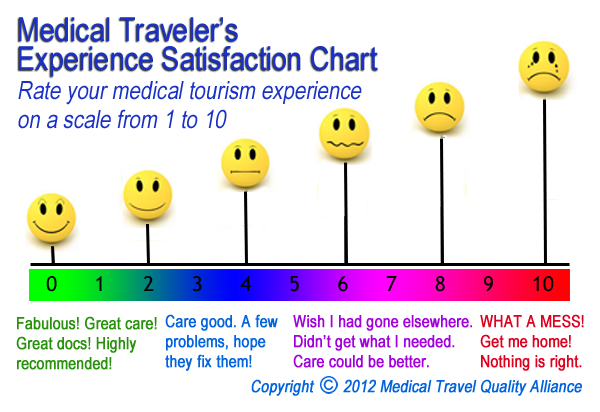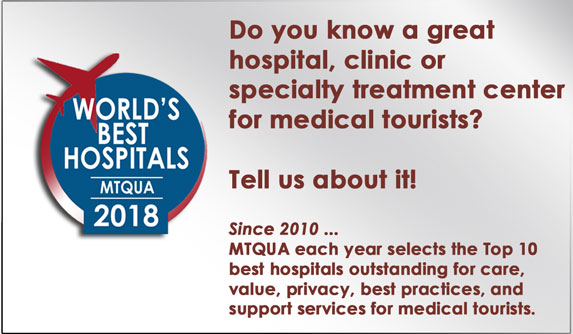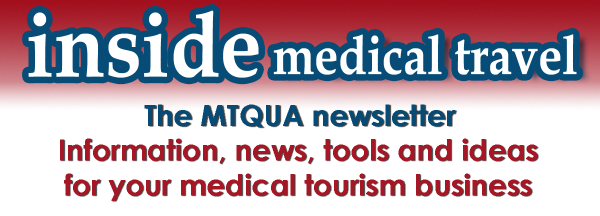
![]() Medical tourism provides an opportunity for hospitals and care managers to bring innovation to the patient experience and enhance customer service in health care.
Medical tourism provides an opportunity for hospitals and care managers to bring innovation to the patient experience and enhance customer service in health care.
When patients have health care choice, and make a personal decision to travel for medical care, they choose to put their medical treatment and care in your hands.
Whether you are an international care manager, a hospital or clinic manager, a facilitator or doctor, your facility and your medical tourism service should always strive to give medical travelers a high quality experience.
11 areas of critical patient touchpoints in medical tourism
Key impact zones for improving patient care fall into these 11 categories.
- Direct and clear communications
- Cultural barriers to treatment and care
- The physical environment
- Patient orientation to international services
- Professional demeanor
- Case management
- Care on the floor
- Care in the ICU and CCU
- Costs, billings and insurance
- Documentation and discharge
- Post discharge outcomes
These impact zones are described in detail in the Best Practices in Medical Tourism report, GREAT EVERY TIME: Delivering Excellent Patient Experience By Managing Critical Touchpoints in Medical Tourism. Its comprehensive review of what impacts on patient care, how to enrich the medical traveler’s experience and improve care can be downloaded here.
Not all changes need a firm commitment from management and staff to implement and maintain. Here are 8 innovative ideas your facility or health care partner can easily execute that will immediately improve the care experience for the medical traveler.
Facilitators can suggest these and other ideas that will make their clients’ experiences at the clinic or hospital positive and less stressed.
8 ways to improve the medical travel experience
-
Signage around the public areas
Some of the most common problems faced by medical travelers are the most basic. Starting with large signs and arrows that clearly show the way to consulting rooms, treatment clinics, cashier, pharmacy, and customer service, they can go far in relieving patient anxiety and keeping patients on schedule.
-
A dedicated quiet contemplation or bereavement room
Family members who have accompanied the medical traveler appreciate a quiet, private place for contemplation or prayer. It can be simply a vacant room on the ward, with comfortable seating. It should of course be multidenominational.
-
Prompt scheduling of follow up appointments
Medical travelers are on timetables. They have flights to catch to return to work on time. Medical travelers need your attention when making any appointment, and should be given priority in all scheduling.
-
Online patient planning kit
Some hospitals and clinics allow patients to make appointments online. A further improvement in online services may be to let patients fill in health profiles, answer admission questions and list their medications. A web-based application can even provide directions and a map, the doctor’s biography, and information about the treatment or procedure choices.
-
Patient care map or flow chart
To ease a medical traveler’s anxiety and answer questions even when a translator is not around, give the patient a laminated (or digital) “care map” with a document checklist, plan of radiology, lab, consults and other stops through the admission process and on to surgery. Include a post operative check list for post-surgery recovery.
-
Links with family or friends
Medical travelers often feel isolated from family and friends. In-room wi-fi and Skype connections help them stay in touch with loved ones.
-
Patient ID bracelets
Plastic wrist bracelets with scanning codes help guard against medication errors.
-
More than translators
For medical travelers who don’t speak the language, laminated cards illustrating all varieties of patient needs can help them express themselves to hospital staff. You already probably have pain scale cards. Add a few more for patients to communicate about basic needs (toilet, bath, drink, ice, food, telephone, doctor, etc.).
What ideas do you have to bring a better patient experience to the medical traveler? Leave your comments below.

 >
>